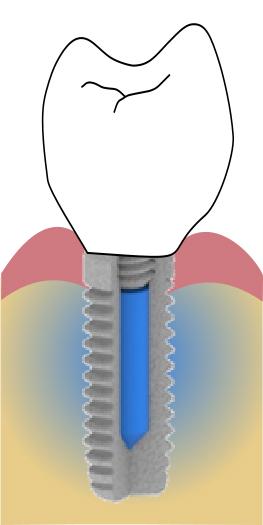New dental implant with built-in reservoir reduces risk of infections

Implant integrated into the jawbone and with a crown on the tooth. Credit: © KU Leuven - Kaat De Cremer
Our mouth contains many micro-organisms, including bacterial and fungal pathogens. On traditional dental implants, these pathogens can quickly form a so-called biofilm, which is resistant to antimicrobial drugs like antibiotics. As a result, these implants come with a significant risk of infections that may be difficult to treat.
KU Leuven researchers have now developed a new dental implant that reduces the risk of infections. “Our implant has a built-in reservoir underneath the crown of the tooth,” explains lead author Kaat De Cremer. “A cover screw makes it easy to fill this reservoir with antimicrobial drugs.
The implant is made of a porous composite material, so that the drugs gradually diffuse from the reservoir to the outside of the implant, which is in direct contact with the bone cells. As a result, the bacteria can no longer form a biofilm.”
In the lab, the implant was subjected to various tests for use with chlorhexidine, a universal mouthwash with a powerful antimicrobial effect.
The study shows that the Streptococcus mutans, a type of mouth bacteria that affect the teeth, can no longer form biofilms on the outside of the implant when the reservoir is filled with the mouthwash.
Biofilms that were grown beforehand on the implant could be eliminated in the same way. This means that the implant is effective in terms of both preventing and curing infections.
###
This study was led by Dr Karin Thevissen, Dr Kaat De Cremer, and Dr Annabel Braem. It is a collaboration between the KU Leuven Centre for Microbial and Plant Genetics, the KU Leuven Department of Materials Engineering, the KU Leuven Biomaterials Research Unit, and the KU Leuven Centre for Surface Chemistry and Catalysis. The study was funded by the KU Leuven Industrial Research Fund.
Media Contact
All latest news from the category: Interdisciplinary Research
News and developments from the field of interdisciplinary research.
Among other topics, you can find stimulating reports and articles related to microsystems, emotions research, futures research and stratospheric research.
Newest articles

Recovering phosphorus from sewage sludge ash
Chemical and heat treatment of sewage sludge can recover phosphorus in a process that could help address the problem of diminishing supplies of phosphorus ores. Valuable supplies of phosphorus could…

Efficient, sustainable and cost-effective hybrid energy storage system for modern power grids
EU project HyFlow: Over three years of research, the consortium of the EU project HyFlow has successfully developed a highly efficient, sustainable, and cost-effective hybrid energy storage system (HESS) that…

After 25 years, researchers uncover genetic cause of rare neurological disease
Some families call it a trial of faith. Others just call it a curse. The progressive neurological disease known as spinocerebellar ataxia 4 (SCA4) is a rare condition, but its…





















